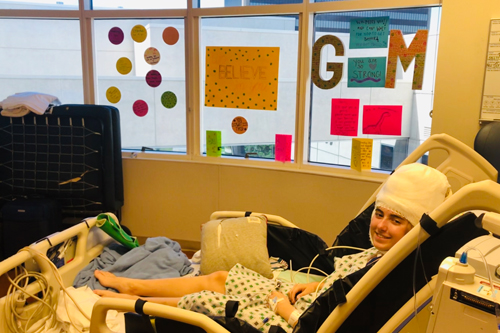
But two years ago, a small lesion that had been in Geni’s brain since birth began making itself known. One night, she woke up and couldn’t move. A few days later, Geni felt tired at school and decided to take a nap in her coach’s office. That’s when she had her first full-on seizure. The next thing Geni knew, she was in an emergency room.
An MRI revealed nothing, as did visits to pediatricians. The seizures continued. The more severe ones occurred at night, while less noticeable ones happened many times a day. Ultimately, she was diagnosed with epilepsy, but she wasn’t receiving the expert care she needed at nearby hospitals.
“It got to be about 15 to 20 seizures a day,” says Susan Masson, Geni’s mom. “We knew we needed to be at CHOC.”
CHOC’s Comprehensive Epilepsy Program was the first in California to be named a Level 4 epilepsy center by the National Association of Epilepsy Centers, the highest level available. That distinction means that CHOC has the professional expertise and facilities to provide the highest level medical and surgical evaluation and treatment for patients with complex epilepsy.
It was at CHOC that the Massons met Dr. Maija-Riikka Steenari, a pediatric neurologist who specializes in epilepsy, also known as an epileptologist.
With epilepsy, parts of the brain go haywire and emit unwanted electrical signals that can cause convulsions and seizures of varying strength. As Dr. Steenari describes it, it’s “a clump of brain cells that don’t quite work the way they’re supposed to, or a cluster of cells in the wrong place. They’re really irritable. They’re known to cause trouble.”
Epilepsy can be the result of brain injury, stroke or, in Geni’s case, a slight anomaly that was present since birth.
Like others diagnosed with epilepsy, Geni’s first option was medication. She was prescribed antiseizure medicines, but they didn’t work.

During this time, Geni was missing school and couldn’t drive or be left alone. But Geni did her best to be a regular teenager and still go to rehearsals.
Geni needed two surgeries, the first one to determine exactly where the problem was. Dr. Joffre Olaya was her pediatric neurosurgeon. The team used grids to map where the seizures came from, within a few millimeters.
The lesion was right next to the part of Geni’s brain that controls language. If her surgeon didn’t have an exact spot to operate, she could lose the ability to speak or write. But Geni was willing to take the risk. Each seizure could cause more damage to her brain and Geni wanted them to stop.
In the second surgery, doctors successfully removed the lesion. Geni faced some challenges after surgery that her family was told ahead of time were possibilities. She was 15 at the time, so before surgery, she had long ago mastered writing without thinking about how to shape each letter. After surgery, she knew how letters should look, but she couldn’t make them. She also couldn’t tie her shoes, brush her hair or teeth, button or zip her clothes, or feed herself. But Geni and her family treated these more like challenges than setbacks, and occupational therapy helped.
“A few weeks after surgery, we went to the library and we got some preschool books on how to write. It was quite frustrating, but luckily, my brain still knew how to do it. It just needed to create new pathways,” Geni says.
Talking was hard after surgery, too. Geni would know what she wanted to say, but finding the right words took a little more time than it used to. She worked with a speech therapist.
It was heart-wrenching for her parents to see their daughter suffer, but they’re proud of how she handled her journey.
“I cry every time I remember how hard this was, and then I laugh at how much Geni thought it was simply annoying what she had to relearn. These kids are fearless little warriors,” Susan says.
Today, Geni has been seizure-free for 14 months. And while her right arm tires easily and she still sometimes has trouble finding the right words to say, someone meeting her for the first time wouldn’t notice. She has her driver’s permit and is working on a project for film class and an online play.
Geni’s neurologist says she should continue to improve with time.
Writer credit: CHOC
Photo credit: Courtesy of Masson family
www.choc.org